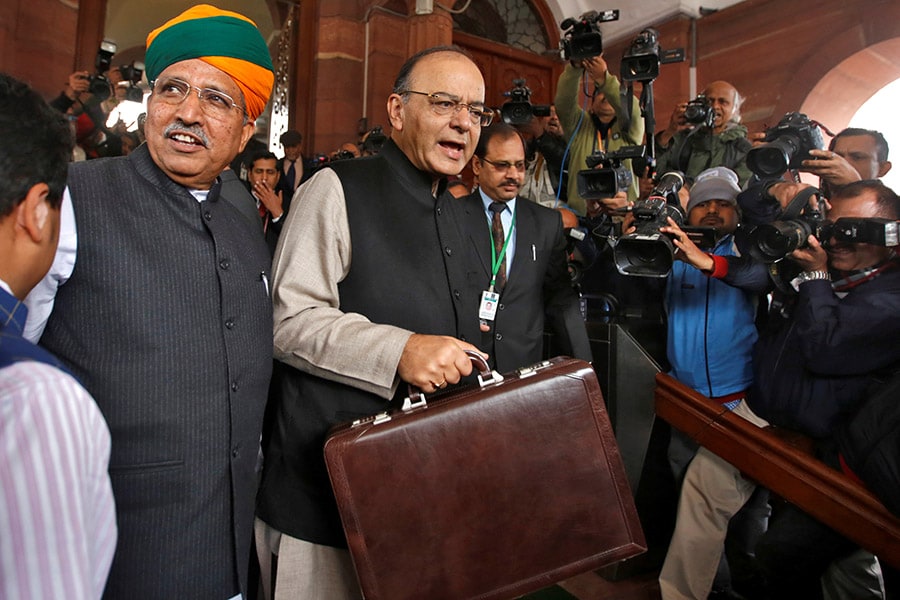Budget 2017: Arun Jaitley's TEC Tonic for a New India
Without any major negative surprises and with an inclusive agenda, Finance Minister Arun Jaitley has sought to power growth in a new global order


 Image: Adnan Abidi/ Reuters
Image: Adnan Abidi/ Reuters
The best budgets are those which do not come up with any nasty surprises, sticking to a broad roadmap in accordance with the needs of the economy. Such budgets are a contextual response to how the economy needs to be nurtured to ensure sustainable growth. If that yardstick is applied to Finance Minister Arun Jaitley’s Budget 2017, it must be said that the FM comes up with first-class marks. Not only has the Budget not surprised on the downside, it has put out a broad framework of where the National Democratic Alliance (NDA) government led by Narendra Modi wants to go. The Budget is also a contextual response to the big move which Modi made on November 8, 2016, of demonetizing high-value currency notes of Rs 1000 and Rs 500 in a bid to flush out unaccounted cash.
As BMR Legal Managing Partner Mukesh Butani appropriately puts it, Jaitley’s Budget has an inclusive agenda, with “more good, less bad, no ugly.” That, to corporate India, markets and taxpaying individuals, can only be good news. Add to that the rural and infrastructural push, and you have a Budget which clearly has the potential to bring back growth despite the global economic challenges.
First things first, Jaitley has stuck to the path of fiscal prudence despite these obvious challenges and the need to kick-start the investment and growth engines. He has given himself just a wee bit of headroom, at 3.2 percent fiscal deficit target for FY18, while committing himself to the 3 percent target the following year, in line with the FRBM Committee recommendations. Importantly, net market borrowings have been restricted to Rs 3.48 lakh crore for FY18, lower than the Rs 4.25 lakh crore of the previous year. The revenue deficit for FY18 is pegged at 1.9 percent, against the FRBM panel’s recommendation of 2 percent. The allocation towards capital expenditure, on the other hand, has been upped by 25.4 percent.
To be sure, Jaitley has clearly spelt out the challenges – the context – against which Budget 2017 must be viewed. In Jaitley’s own words:
&bull The world economy faces considerable uncertainty, in the aftermath of major economic and political developments during the last year
&bull The US Federal Reserve’s intention to increase policy rates in 2017 may lead to lower capital inflows and higher outflows from the emerging economies
&bull Uncertainty around commodity prices, especially that of crude oil, has implications for the fiscal situation of emerging economies
&bull Signs of retreat from globalisation of goods, services and people, as pressures for protectionism are building up.
Against this background, Jaitley’s TEC India (Transform, Energise and Clean India) roadmap seems to be a prescription in the right direction. The Budget aims to focus not just on the poor and underprivileged, it also lays emphasis on the farm sector, infrastructure and also pushes forward the initiative towards a digital economy, among other things. The idea is to chart out a broad, holistic agenda which will ensure the resulting growth is sustainable.
Alongside, Jaitley has made some important moves. He has given a big push to affordable housing granting it infrastructure status, abolished the Foreign Investment Promotion Board and aimed at further liberalizing foreign direct investment and committed to bringing in more central public sector enterprises (CPSEs) into the listing ambit. The exchange traded fund (ETF) route to getting CPSEs into the bourses will also be a preferred route. He has lowered the tax burden on companies below Rs 50 crore turnover, cutting their tax rate to 25 percent and aiming therefore to give a push to MSMEs and small companies. Startups have also been kept in mind, with some further relaxations to this category. Corporate tax for large firms has been kept unchanged and only some minor tinkering in MAT has been undertaken), but from a stock market perspective, the fact that the much-speculated changes in the long-term capital gains (LTCG) tax has not been undertaken is enough cause for celebration.
One of the biggest initiatives, and one which is bound to find support from a cross-section of Indians, is the attempt to clean up electoral funding: Political parties are now barred from accepting over Rs 2000 in donations in cash from any single source. Parties can take donations by cheque and digital means. The government would also come up with a scheme on electoral bonds.
Jaitley’s Budget also aims to put some more money in the hands of those at the bottom of the taxpaying slab, many of those who had to stand in the long queues at banks and ATMs in the days immediately following demonetisation. Consequently, individual assessees who are within the income bracket of Rs 2.5 lakh and Rs 5 lakh will now be taxed at 5 percent, down from the earlier 10 percent. On the other hand, those in the annual taxable income bracket of between Rs 50 lakh and Rs 1 crore will have to shell out additional surcharge at the rate of 10 percent.
With the Goods and Services Tax (GST) regime now round the corner and a digital push to the economy well under way, Jaitley will be hoping that FY18 and beyond would see the foundation being laid of a new, more transparent economy, with the multiple engines of growth gradually coming back into operation. The finance minister’s speech also made it clear that the drop in economic activity on account of demonetisation would be temporary and the effects would not spill over to FY18. If that assumption holds good, and the formal economy expands as expected as a result, this Budget could go a long way in ensuring it is what it was sought to be: The Big Reboot.
First Published: Feb 01, 2017, 20:29
Subscribe Now